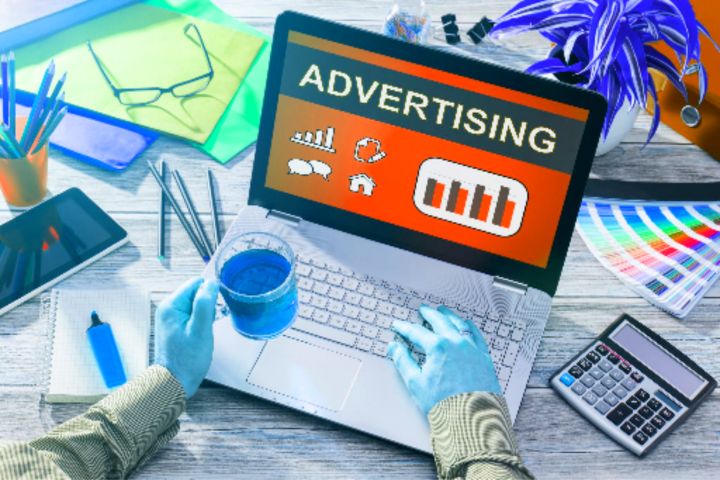Digital Advertising, How To Implement A Winning Strategy

Many companies decide to invest in digital advertising but are often disoriented because there are numerous channels and tools: let’s find out how to implement a winning strategy.
In recent years, many companies have understood the need to structure a solid online presence, communicate with their customers through new channels and start a digital transformation process. They have started developing strategies, creating content for web users and investing in digital advertising.
Digital advertising is a form of advertising that uses digital channels to send promotional messages to well-profiled potential customers. It represents all the activities undertaken to promote a product, service, event or initiative.
There are many advantages over traditional forms of advertising. For this reason, the number of organizations and professionals who use them to achieve their marketing objectives is constantly growing.
With an Internet connection and basic knowledge of IT tools, launching digital advertising campaigns is simple.
Making them effective and implementing a winning strategy, however, requires in-depth knowledge of all the tools and channels made available by the web, an analysis of the context, a precise identification of the objectives to be achieved, careful planning and consideration of a series of aspects and elements that can determine the success or failure of advertising initiatives.
Table of Contents
Digital Advertising And Traditional Advertising: The Differences
- Before the advent of digital and the diffusion of the Internet, advertising was carried out through other channels. Radio, newspapers, magazines, catalogs, flyers, billboards and television were the leading tools companies that wanted to communicate with a broader audience chose to use.
- Digital advertising captured the attention of advertisers, who soon understood all its peculiarities and, above all, its advantages. It is highly targeted, as it affects a particular audience segment indicated to the platforms by the advertiser and is highly customizable.
- It is measurable, thanks to the evaluation of essential data and Key Performance Indicators that provide information on the effectiveness and impact of campaigns.
Digital Advertising: The Importance Of Planning
- Before starting any advertising activity, it is advisable to conduct a careful analysis highlighting the context in which the company or the professional operates, its strengths, weaknesses, the difficulties that could be encountered and the opportunities to seize.
- During the analysis phase, some essential elements should be identified. First, to choose the right advertising channel and format, you need to know your target audience. One or more targets must be identified in the most specific way possible, profiling them based on attributes such as demographic data, passions, behaviours, habits, interests, etc.
- It is necessary to establish the objectives to be achieved. These must be SMART, i.e. specific, measurable, relevant, achievable and fixed over time with a deadline within which they must be achieved.
- It is advisable to establish a budget for digital advertising campaigns.
- In this way, it will be easier to choose the platform and strategy to apply to achieve all the objectives.
- Web campaigns, especially those based on the pay-per-click (PPC) method, are cheaper than those carried out on traditional channels. Generally, the established amount is paid only when users take action after viewing the ad.
- Even after going online, online campaigns can be improved. By studying the data, it will be possible to understand how to intervene and make them more effective if the objective identified in the planning phase still needs to be achieved.
Digital Advertising: How It Affects The Customer Journey
- The customer journey indicates the path each customer takes to arrive at a specific purchase or choose a specific service. Before the advent of digital marketing, it was very linear and much less complicated.
- Today users can obtain information and stimuli on different platforms and devices. The process of influencing consumer decisions is complex, but the customer journey map is still valuable during the campaign design and planning phases.
- Knowing which stage of the decision-making process the user is in allows you to create an effective campaign and identify the right point of contact to bring the potential customer to be interested in a company’s products or services.
- Mapping the customer journey makes it easier to develop content for all the channels you choose to use for digital advertising.
- Users go through multiple stages. It begins with awareness and discovery ( awareness ), in which the individual becomes aware of his desire or need and tries to understand the right way to satisfy it. In this phase, for example, it is beneficial to carry out campaigns that aim to increase knowledge and awareness of the brand.
- The second phase is that of consideration or consideration. After collecting the first information, the individual understands the most exciting solutions. He will research products and services, compare offers and listen to the opinion of other users. In this stage, it is essential to be present on social platforms, create informative content and launch campaigns on search engines.
- The third stage is that of conversion, in English, decision. After becoming aware of his needs and looking for possible solutions, the consumer arrives at the purchase. It would help if you convinced him to choose your company’s service or product over that of your competitors, so it’s good to offer more information on what differentiates him from others or incentivize him through discounts, coupons, free shipping and offers.
- The process continues after the customer has made the purchase: we must continue cultivating the relationship with the consumer, asking him for feedback and reviews, assisting with customer care services or stimulating his curiosity with new proposals.
- Finally, it is good to retain the customer. If satisfied, not only will he continue to buy the products or use the service, but he will also tend to recommend it to others by spreading the word in favour of the company through tools such as reviews on websites and social media or even posts in which he recommends the purchased good.
- All content created by satisfied customers can be used and highlighted on their communication channels to help customers go through the decision phase.
- It is evident that the user has different interests and needs in each stage of the journey leading to the purchase decision. Knowing how to intercept them and show them only what they need will make the campaigns more effective, increasing their conversion rate.
What Are The Formats Of Online Advertising
- Digital advertising can be exploited on all the channels that make up the users’ online experience. Therefore, it can be found on websites, search engines, social networks, blogs, forums, and emails.
- Banners, videos, images, audio and so on: many formats can be used creatively for original and impactful digital advertising
- Several formats can be used to create an online advertisement. Banners can be created, generally composed of an image or a multimedia element, a few writings that arouse the user’s curiosity and a call to action. They are placed on website pages, can be static and dynamic, and have different sizes: rectangular, square, pop-up, buttons and skyscrapers.
- Video advertising is one of the most used formats for online advertising. This format makes it possible to create commercials that attract the user’s attention and have a high conversion rate. They can be shown in streaming content, such as the pre-roll. Alternatively, they may appear in textual content or web pages. This is the case with banners and pop-ups.
- Like videos, image advertising also has a high engagement power.
- The photos are engaging and convincing for users going through the decision-making process to reach a purchase and are an excellent stimulus for further study.
- Remember to underestimate audio advertising, which is increasingly influential, especially for users who receive it on smartphones or use speakers extensively. However, other devices are not excluded, such as PCs and tablets. In any case, the user does not need a screen turned on to receive it but can listen to the ads while carrying out other activities, for example, on Spotify or Youtube.
- Audio ads blend seamlessly into other content and are often not skippable by the user. They can be pre-recorded audio elements conveyed within other audio streams (for example, in music streaming on demand) or announcements read by speakers for product or service sponsorship (for example, within podcasts).
- Other usable formats are emails and newsletters. To be effective, they must be addressed to a well-targeted audience and have content that responds to specific needs. The advertisement arrives directly in the user’s email box.
The Power Of Display Advertising
- Among the possibilities of digital advertising is display advertising, an advertisement made online in unique paid spaces made available by publishers and website owners. The aim is to promote a product by intercepting users while looking for information, news or content on the web and to get them to perform a specific action (for example, click on a link).
- It is necessary to identify the spaces to be used well to hit a target potentially interested in the products or services offered. Typically the ad server does this based on information provided by the advertiser.
- Google ADS is one of the most used platforms to launch display campaigns, as it allows you to show ads on an extensive network of websites.
- Generally, display ads are made through banners, but other formats are not excluded. The most used form is Pay Per Click (PPC), which allows the advertiser to pay only when the user notices the ad and performs the desired action.
Search Engine Marketing (SEM): Intercepting User Searches
- Search Engine Marketing is one of the most used digital advertising possibilities. It allows you to position yourself at the top of the search results pages, undermining the competition. The goal is to intercept users while they are looking for information on search engines and bring them to your website.
- The SEM consists of a series of activities to generate qualified traffic to a site. Paid campaigns, generally PPC, are activated by purchasing advertising spaces within search engines.
- It’s an effective tool, especially when crafting a quality campaign that users don’t perceive as annoying. Since it is necessary to intercept users’ search intent, the search engine marketing activity is based on a careful analysis of the keywords.
Social Media Advertising: Advertising On Social Networks
- Every day web users spend a lot of time on social networks. They do this to communicate with friends, relatives, colleagues or strangers with whom they want to establish a relationship, entertain themselves or receive valuable information.
- When advertising on social networks, it is necessary to create content with a strong impact, which can capture the attention of users who are already immersed in a continuous flow of posts, images and videos. Social networks allow advertisers to intercept a large pool of highly profiled consumers, which they could hardly reach in any other way.
- Now advertising can be done on all major social networks, including Instagram, Facebook, Linkedin, Twitter, and Pinterest. The platforms have developed solutions dedicated to advertising and sections where they can manage advertising campaigns independently.
- They allow you to establish the budget of your ads, identify a precise target to send messages to, plan campaigns and obtain real-time data and information on the results you are achieving.
Direct Email Marketing (DEM): A Valuable Tool
- Even today, emails are a powerful tool for online advertising and can produce a high conversion rate. Direct Email Marketing (DEM) is often included in the strategies of companies and organizations that want to communicate with their audience and push them to make purchases or use the services offered.
- DEMs have a competitive cost compared to other digital advertising activities, a high return on investment and a high level of customization.
- Email messages are targeted and highly persuasive; they are sent to an audience that has already shown interest in the product or service. The objectives that can be achieved with this type of activity are different: customer loyalty, lead generation and nurturing of the users present in the database.
Native Advertising: An Excellent Investment
- Native advertising is a form of advertising that takes on the appearance of the content of the site or platform where it is hosted. Overcome hostility from readers who aren’t distracted by the ad. They can be inserted in an editorial context as articles, on social networks as posts, search engines as results for specific keywords and so on.
- Native advertising, in order not to be confused with other types of content, is always reported and marked as ‘advertising’ and ‘sponsored content. The user, therefore, is always aware of being faced with an advertisement.
Mobile Marketing: advertising on smartphones
- The smartphone is ubiquitous in people’s lives and replaces personal computers. Almost everyone has one and uses it not only to make phone calls or send messages, but to obtain information, take advantage of essential services, and simplify daily actions. They represent an excellent opportunity for companies that want to start digital marketing actions.
- The mobile marketing channels are applications, browsers, instant messaging or the classic SMS and MMS.
- The formats that can be used are digital advertising on other devices: videos, banners, images, audio, text, etc.
What Is Digital Out-Of-Home Advertising (DOOH)
- Traditionally, out-of-home advertising refers to all ads presented to the public outside the home. These are, for example, posters, street furniture and transit advertising on means of transport.
- With the advent of new technologies, this type of advertising has also evolved. Today, many realities have decided to take advantage of Digital out-of-home advertising (DOOH), a broad and still poorly defined but constantly growing field. It refers to all multimedia and dynamic content transmitted through screens and tools in public places and environments other than domestic ones.
Digital Advertising KPI: How To Evaluate The Impact Of An Advertising Campaign
- One of the significant advantages of online advertising is the possibility of having full awareness and knowledge of the results obtained from one’s actions by accessing a series of data, metrics and information that the platforms return.
- By studying and analyzing the KPIs of digital advertising, increasingly effective advertising campaigns can be structured. You can evaluate the leads obtained, the clicks on the ad and the coverage. There are different types of metrics, depending on the type of advertising and the platform used.
- In SEM campaigns, important KPIs are the number of conversions, the cost per conversion, the conversion rate or the Click Through Rate (CTR). In social media advertising, the engagement rate, the number of interactions and the increase in the community. In email marketing, however, the open email rate, deliverability rate or unsubscribe rate.
- In the campaign conception and planning phase, all the metrics that can indicate the campaign’s progress must be constantly identified and monitored.
- Only in this way will it be possible to understand whether the advertising activities being carried out represent success or, on the other hand, whether it is necessary to quickly make changes to one’s strategy to avoid not achieving the objectives set and losing precious resources.
The Future Of Online Advertising Without Cookies
The world of online advertising is about to change dramatically. Many companies, organizations, agencies and digital marketing professionals will have to radically change their strategies and find new ways to communicate with potential customers, attract their attention and guide them towards a conversion. We are moving towards a future without third-party cookies.
Browsers are already adapting to a cookieless reality to respond to the needs of all users who have asked for greater transparency on the use of their data. Cookies are the element that makes it possible to profile the public in detail, favouring the creation of targeted and highly influential content and strategies.
There are two types of cookies: technical ones used to personalize the user’s experience within a website, and profiling ones, which help understand users’ interests. The cookies used to identify the characteristics of the visitors can be owned by the site manager or third parties, i.e. created by the web server of an external site.
Despite the cookie policy, collecting information from third parties has raised problems and questions relating to protecting privacy.
Cookies from third parties will disappear, and the consequences on the online advertising industry will be inevitable. Those involved in data collection, monitoring and management will be the most difficult.
The user’s path from the moment he encounters the first input to the moment he arrives at performing a specific action will no longer be reconstructible. It will only be possible for investors to carry out retargeting activities.
You will have to fully exploit all the information from first-party cookies and implement new solutions to obtain proprietary data independently. Search engines are also trying to develop new services to offer advertisers the possibility of structuring targeted campaigns.






